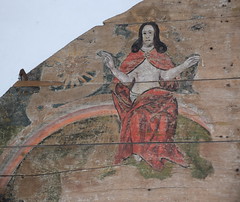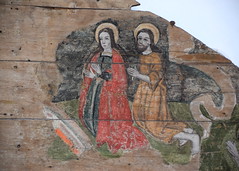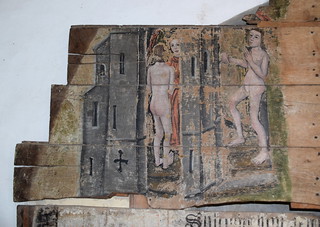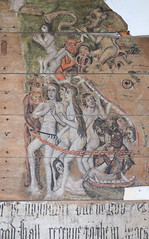| |
|
Follow these journeys as they happen at Last Of England
Twitter.
Wenhaston, pronounced wenn-er-st'n,
is a fine village on the Blyth, not far from two of
Suffolk's most important stopping off places for church
explorers, Blythburgh and Westhall. One of the thrills of
visiting Suffolk churches is the anticipation and shock
of amazing medieval survivals. There is that font at
Westhall, the retable at Thornham Parva, the wall
paintings at Wissington and North Cove, and much else
besides. Some churches, like Ufford, Bramfield and
Westhall, seem to have more than their fair share. It is
easy to blame the Victorians for destroying medieval
features, but, in many cases, it was the Victorians who
rescued and restored them. Many of the medieval objects
in our churches today would not have survived if it were
not for the Victorians. And yet, perhaps the most
significant medieval art object in the county exists by a
supreme irony, for if it had not been for an act of gross
19th Century carelessness, it might not have survived at
all.
If they had been efficient, the decaying wooden tympanum
taken down from above the chancel arch at Wenhaston in
the summer of 1892 would have been stripped, repaired and
painted. Instead, it lay out in the churchyard waiting
for someone to do something with it, while the
restoration continued inside. That night, it rained. The
whitewash, applied centuries before, dissolved. When the
workmen arrived on site the following day, they saw
wonderful things.
What the rain revealed is essentially a doom painting,
although there is a little more to it than that. A doom
shows the final judgement of souls after death; each
person comes equally before the throne of God, and is
selected to go to Heaven or to Hell. Probably, all
churches had them. The one at North Cove is on the north
chancel wall, but ordinarily the doom was above the
chancel arch, usually painted directly on to the plaster
as survives at Earl Stonham and Cowlinge. Where there was
no chancel arch, or the chancel was not sufficiently
lower than the nave to allow a painting, the top of the
arch would be infilled with a wooden tympanum.
Why is the Wenhaston Doom so significant? Although few
dooms survive in Suffolk, there are quite a few elsewhere
in the country. But the Wenhaston Doom is special for two
reasons. Firstly, in front of the chancel arch stood the
great rood, a feature of every medieval church, Christ
crucified, flanked by his mother and St John. The rood
was supported on a rood beam, or suspended from the
ceiling, above the roof loft and rood screen. Every
single rood in England was destroyed by Thomas Cromwell's
cronies in the 1540s. Not a single one survives.
We can see at Earl Stonham the way that the centre of the
doom painting has fewer details, since it would be
obscured by the rood. However, at Wenhaston, the rood
group was actually attached to the tympanum, and although
it was ripped off in the 1540s, the outlines of the
crucifix and flanking figures survive, like ghosts of
lost Catholic England. The other reason that the
Wenhaston Doom is significant is that its colours are so
bright, and its details so vivid. There's nothing else
like it in the country.
When was it built? Wills specialist Simon Cotton tells me
that in 1480 there was a bequest towards a new screen.
Since the tympanum would have followed the construction
of the screen and rood, then a date in the 1500-1520
period for the Doom seems likely. So it was completed
about 25 years before its destruction, that's all.
The last trump is sounded and the dead rise from their
graves. Christ sits on a rainbow, overseeing everything
that is going on. His mother and St John the Baptist
bring forward intercessionary prayers for the souls of
the dead. However, the real battle is between St Michael
and the Devil, who have charge of the scales, and weigh
each soul against its unreconciled sins. St Peter is seen
receiving nobility - we can tell from their headgear that
they include members of the Royal family, a Bishop and a
Cardinal. However, they are otherwise naked, to signify
that all are equal before God. So they'd better have a
good excuse... To the left, souls are received into
Heaven, while those on the right are marched off to Hell.

 
   
What happened to this amazing art object in
the middle of the 16th century? After the rood group was
removed and burnt, it was whitewashed over. Why was it
not removed? Simply, the order was that roods were to be
replaced with coats of arms, to remind congregations that
the State was in charge now. The tympanum provided the
best way of displaying the coat of arms as it had the
rood.
Fear God and Honour the King was the new
watch-phrase, but at Wenhaston, more was felt necessary.
Along the bottom of the tympanum (and thus below the coat
of arms) was added from St Paul's Letter to the Romans: Let
every soule submyt him selfe unto the authorytye of the
hygher powers for there is no power but of God. The
powers that be are ordeyned of God, but they that resest
or are agaynste the ordinaunce of God shall receyve to
them selves utter damnacion. For rulers are not fearefull
to them that do good but to them that do evyll for he is
the mynister of God.
When Edward VI died in 1553, and his half-sister Mary I
ascended the throne, the English Church restored its
connections with the European Church, and the coats of
arms were removed. Officially, the roods were meant to be
replaced, but this doesn't seem to have happened in many
places. Most likely, there simply wasn't time, for Mary
died in 1557, and the roods came tumbling down again
under the orders of her half-sister Elizabeth. The break
with Rome was made final, and the new Church of England
was born.
There seems to be an orthodoxy of thought that our
English churches were painted with pictures because the
people were ignorant, and this was their only way of
learning theology. There is no evidence for this. On the
contrary, the ordinary people of England seem to have had
a rich spiritual and liturgical life, to which the
furnishings of their churches only contributed a small
part.
No, the creation of these extraordinary folk art objects
was an act of devotion, and we mustn't get sidetracked
into thinking that they were lost because they were no
longer necessary. They were destroyed, wilfully and
purposefully. But some survived, and Wenhaston's Doom
painting is simply one of the most beautiful.
The chancel that once stood beyond it has gone, replaced
in the 19th Century with one that seems a little
over-grand for the size of the church. At the west end, a
charity board and a good royal arms for George III huddle
around the font. The font is instantly recognisable as
one of the Seven Sacraments series, but the reliefs are
all completely vandalised. The surviving colour reminds
one of Westhall, and this was probably in a group with
the similar fonts at nearby Blythburgh and Southwold.
You'll be appalled to learn that at least some of the
carvings survived into the early 19th century, until
someone took it upon himself to cleanse the font of them.
He's the one in the doom you can see being led away to
Hell.
Simon Knott, May 2019
Follow these journeys as they happen at Last Of England
Twitter.
|
|
|

